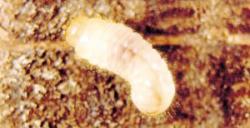Adult
Size
4 to 6.5 mm long.
Aspect
Elongate insects, with parallel sides, slightly flat, quite visible wide head with powerful mandibles.
Eleven-articled antennae, antennal clubs formed of 2 articles; antennae slightly longer than the thorax. Sides of the thorax more or less parallel and finely crenulated (scalloped), with a long dimple in its middle. Elytra about 2.3-fold more in length than in width. They have parallel rows of quite visible dots, the pubescence is also in rows, and made of golden flat bristles pointing toward the rear end.
Colour
Entirely yellowish brown to red brown.


 Lycte ligné
Lycte ligné  European Lyctus beetle
European Lyctus beetle  Carocoma des parquets
Carocoma des parquets  Parkettekäfer
Parkettekäfer 

